After my brief repose at the flat, I went down and took a seat in one of the bars that are located right there where I was staying. Soon I saw Cristina coming with Roberto, her husband, and Ashley, their foster daughter. To start with, we concluded we had not seen each other for some 20 years, but I must admit it did not seem that long to me, plus, I had an impression Cristina had not changed at all and neither had Roberto who had only gotten some gray hair.
Cristina is my pen-friend. What does it mean? It means writing letters, putting papers in an envelope, sending it by mail, then waiting for a response and finally joy when in your mailbox you see an envelope sent by your friend. And doing this for over 30 years. I started corresponding with people from all over the world at the end of my secondary education, primarily in order to practice English, as well as to have some connection with that world. At some point I corresponded with almost 40 people, including pen-friends from such far and exotic places like Trinidad and Tobago, and the Seychelles. Nowadays, I write letters much more rarely than before, but I still rejoice when in addition to bills and ads I see in my mailbox a letter sent to me now by only one of the two pen-friends – Cristina from Italy and Christine from Belgium.
I first met Cristina many years ago in Rome where she used to live with her mom. Afterwards she got married and moved to Milan. I was even once a guest at hers and Roberto’s when I bothered with the nostrification of my diploma in Italy. And then many years have passed and we met again this time in Bergamo.
We all sat at the bar for a while and then we slowly headed uphill in order to get to a funicular leading to the Upper Town. Cristina and I chatted in English, which Roberto also speaks, although he mostly talked in Italian with Ashley, but I did try every now and then to revive my Italian in order for all four of us to speak about the same things. It was good, so it was fun and the communication went well.
When we got to the Upper Town, we first walked along the main street leading from the funicular to the spacious Old Square (Piazza Vecchia) from which one passes under the arches carrying the upper construction of Palazzo della Ragione in order to get to Colleoni Chapel, Santa Maria Maggiore Basilica and the Cathedral.
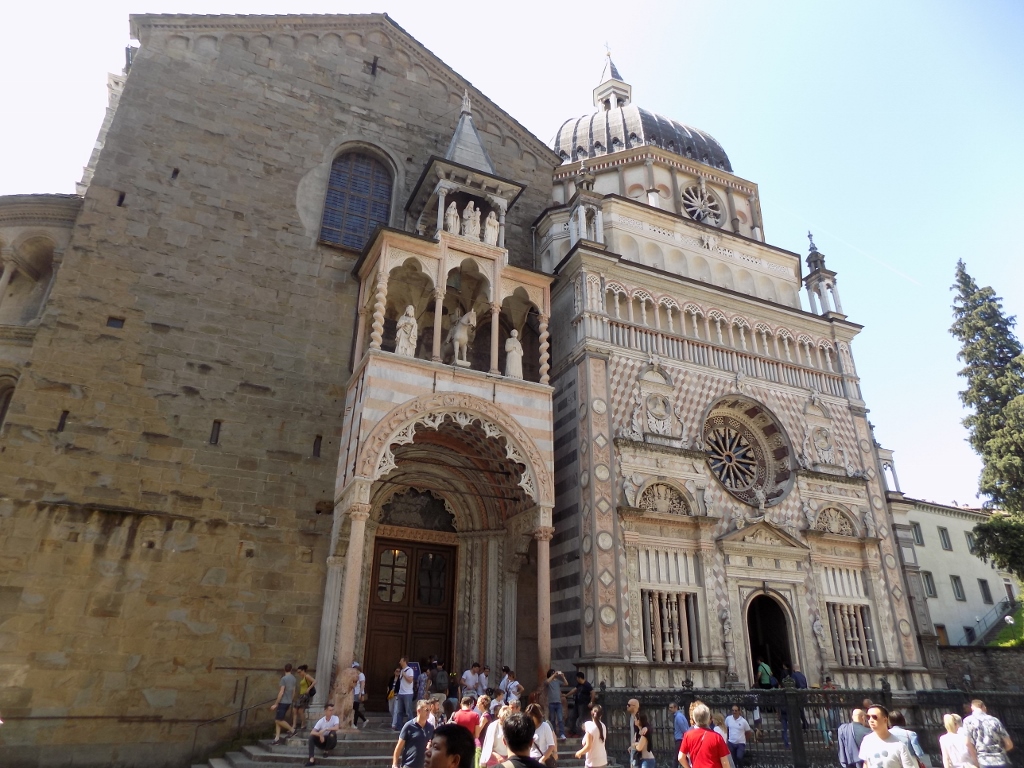 Santa Maria Maggiore Basilica and the Colleoni Chapel
Santa Maria Maggiore Basilica and the Colleoni Chapel
The Colleoni Chapel was built in the second half of the 15th century as a mausoleum for condottiere, military leader, Colleoni and it contains frescoes done by Tiepolo, the famous Venetian painter. Inside, there is also a sculpture of Colleoni on a horse, but what I found even more impressive was the facade made of different-colour marble, along with additional diverse decoration.
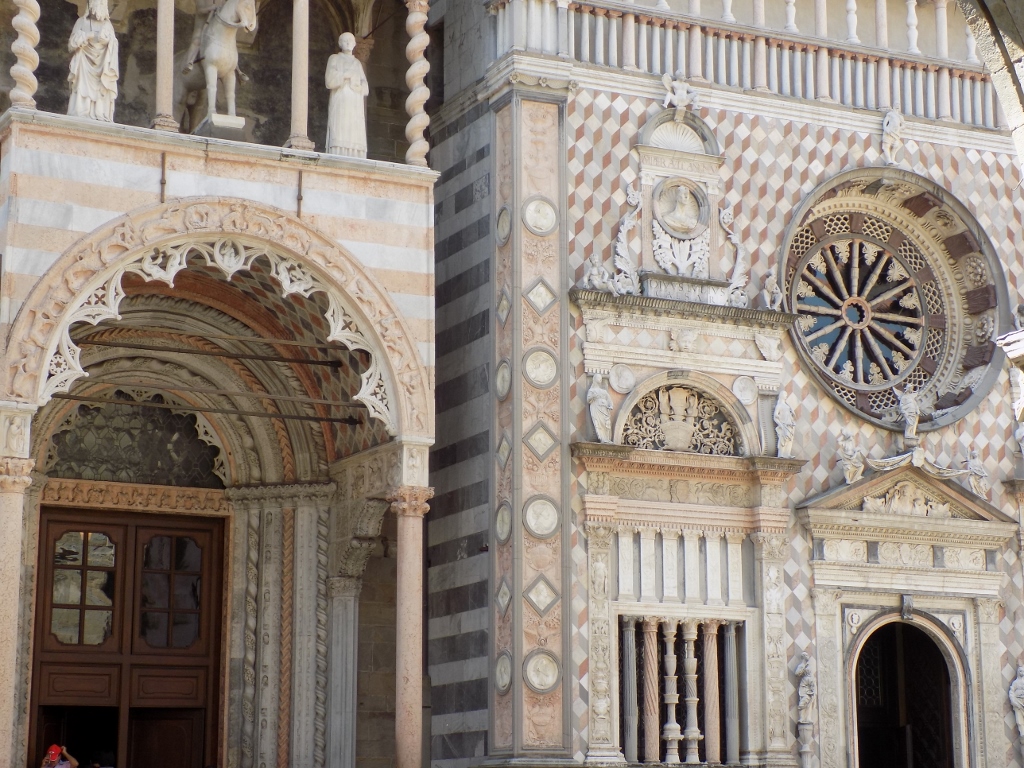 Details of the entrances and facades of Santa Maria Maggiore Basilica and the Colleoni Chapel
Details of the entrances and facades of Santa Maria Maggiore Basilica and the Colleoni Chapel
Although it seemed to me that the previous day I had remembered very little since I had concentrated more on the conversation with Martina and Mauro, it turned out that this time around I could even point at some interesting things to Cristina and her family. At the same time, I was also significantly fresher this day, since I had slept longer and travelled less, which made me more relaxed for impressions, so I even remembered to take photos.
This was also the case when we entered the Romanesque Church of Santa Maria Maggiore. It dates back to the 12th century, but the additions were being made all through the early 17th century and nowadays it contains exceptional tapestries, frescoes, panels and very opulent decoration.
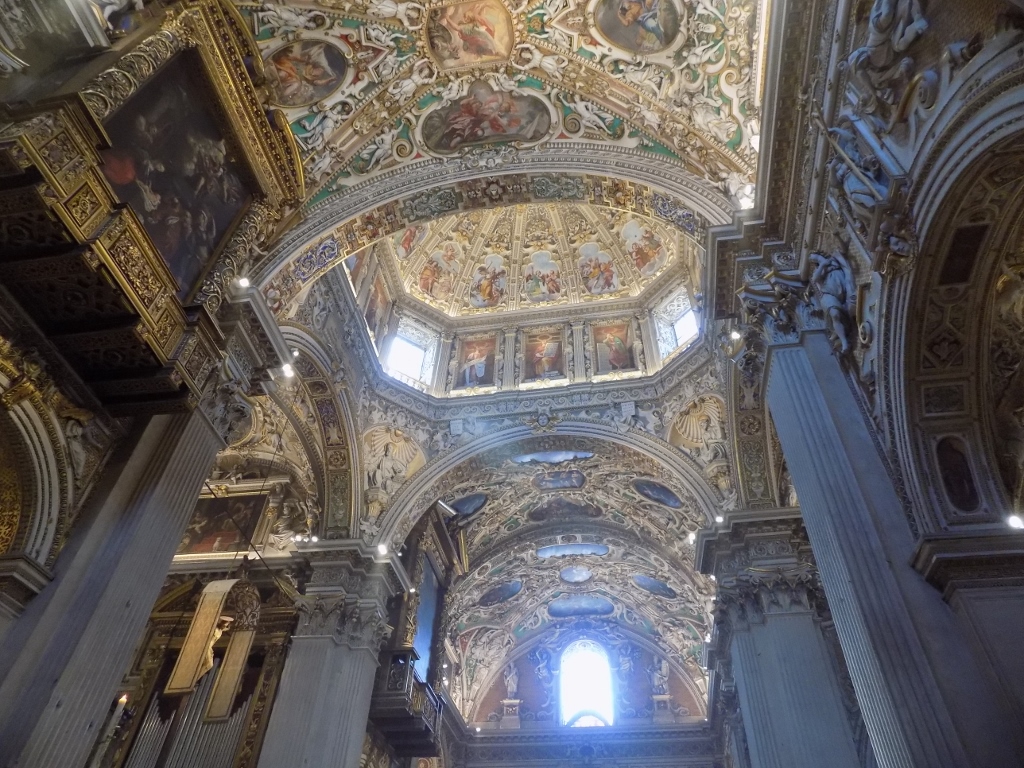 Impressive interior of Santa Maria Maggiore Basilica
Impressive interior of Santa Maria Maggiore Basilica
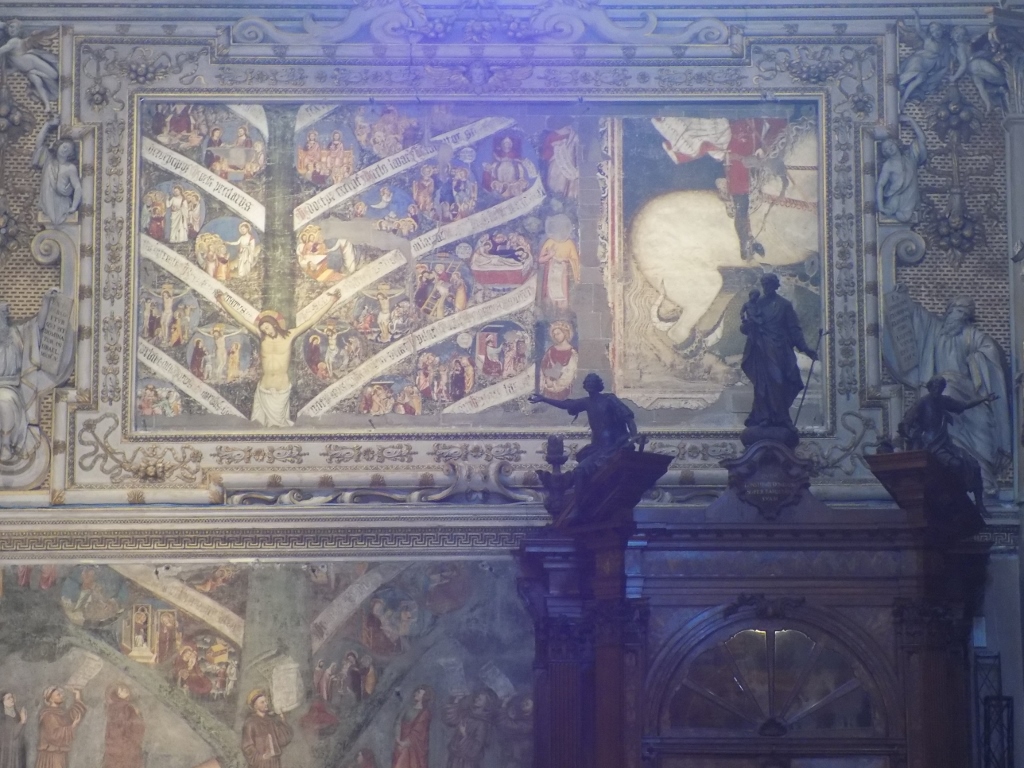 Details from Santa Maria Maggiore Basilica
Details from Santa Maria Maggiore Basilica
Then we all went for lunch to a trattoria and there we first had some local specialties – great salamis and prosciuttos. Still, as far as pasta is concerned, although the place did offer casoncelli alla bergamasca, I opted for gnocchi with different cheeses and I did not regret my decision.
After lunch, we walked back to the Lower Town where I saw my friends off, while I returned to the flat. After the good lunch, I enjoyed withdrawing to the quietness of the flat, especially since it was rather hot that day. It was April, the weather was fine, the sky was perfectly blue, but from time to time it seemed almost as if it were summer. Still, I had no complaints, I only had a short rest.
And then I remembered that the previous day Martina had given me a free ticket to one of the best museums in the town and I realized I had just the right amount of time to go there and visit it. This concerns the Academia Carrara and it’s not a large museum, but is rather nice, especially for those primarily interested in the local Italian painting from the 15th to the 19th century.
The museum is located in a different area of the town from the one I was staying in, which meant a new walk. At some point, I couldn’t be bothered with the checking of the map, so I soon concluded I did not follow the shortest route, but was again walking uphill. This thing with going constantly uphill this day seemed to be too much, but I also thought it was good for me especially having in mind my next destination.
Be as it may, I first reached the Sant’Agostino Gate which as a part of the Venetian defence walls used to serve as the main entrance into the Upper Town.
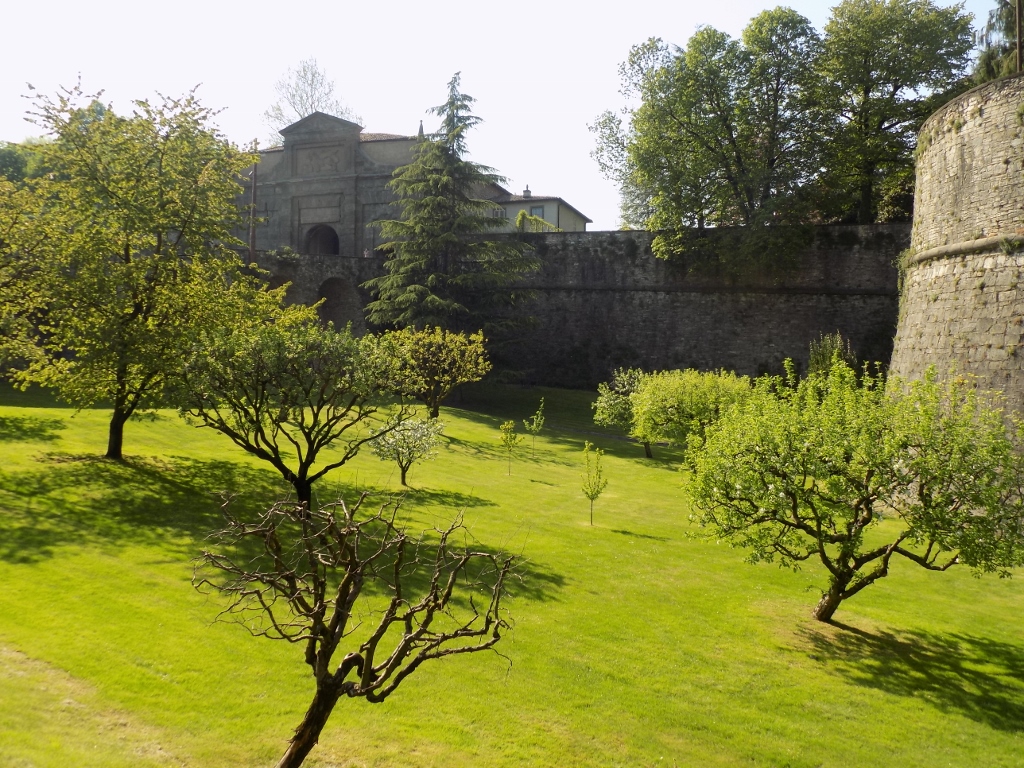 Sant’Agostino Gate and the fortification walls
Sant’Agostino Gate and the fortification walls
Here it was also possible to see nicely the ramparts that belong to the fortification built by the Venetians within the scope of the defence works they conducted in the 16th and the 17th centuries.
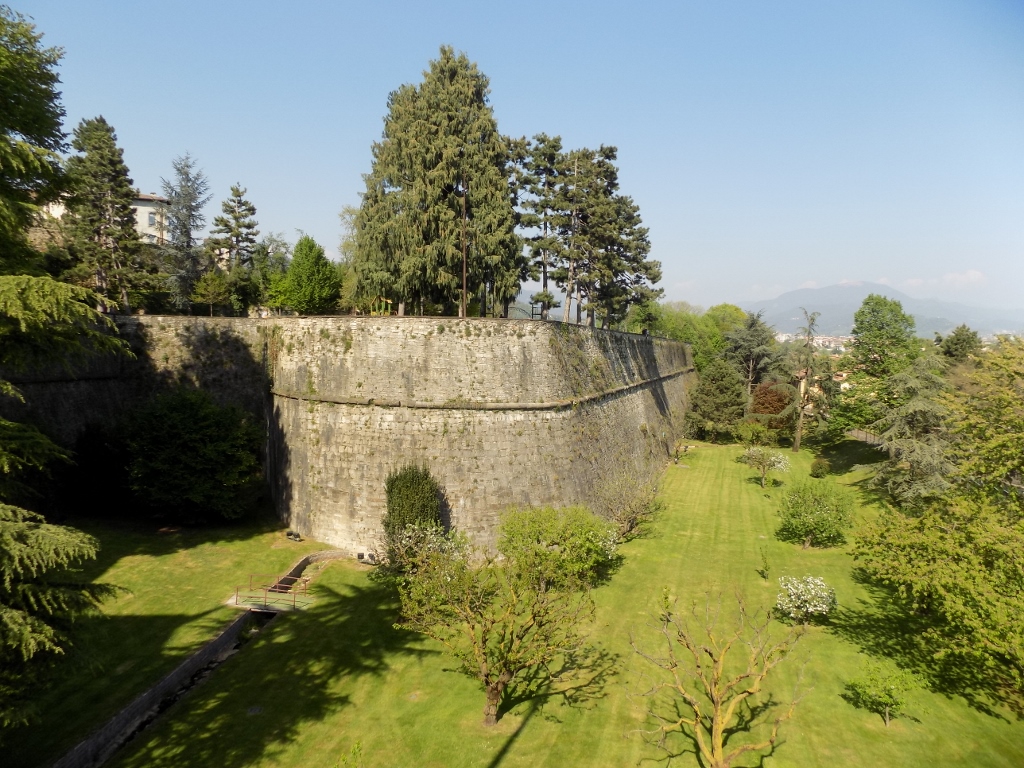 Fortification walls encompassing the Upper Town in Bergamo
Fortification walls encompassing the Upper Town in Bergamo
From there I followed a pedestrian passage to a lovely spacious square where there is not only the Academia Carrara, but also the Modern Art Museum, but for this day it was enough for me to visit just one of them.
The Academia Carrara is a very nice and importantly not too big a museum, so my visit had just the right measure. The artistic gallery was created on the basis of the rich collection made by Count Giacomo Carrara who died at the end of the 18th century and after whom the museum was named. The collection keeps being expanded.
My map showed that in this area there was also some kind of a centre of the night life, but at around 5 pm on a Sunday, the street I walked through and in which I did see several bars was quiet, while all the shops and bars were closed. I actually needed to find some place to sit down and have a coffee, since I had already gotten a bit tired. So, I just turned on my heels and headed back to “my” part of the town. On my way, I went along a busy street through which numerous motorbikes passed in waves created by traffic lights and they all honked a great deal and I could see that most of the riders of the motorbikes and their passengers had blue and black clothes. Since I had already heard the chanting of football fans in the distance while I was by the Sant’Agostino Gate, I realized the match had been finished in the meantime and that the fans who were going back home thought they should keep making noise, this time using the horns on their motorbikes.
Having passed through a park that was filled with parents with children, I soon reached the Pignolo street that I had visited the night before. It is a picturesque street which waves its way up the hill. One part of it is pedestrian, while in another there are cars. I went down this street to the flat section and there I headed straight towards Piazza Giacomo Matteotti, thinking I would sit in one of the cafés in Via Sentierone, but the cafés there were all full. I saw there was no point in waiting, so I just took a few photos and then went directly back to the square at which I stayed, where I could finally sit down, have a coffee and a good rest.
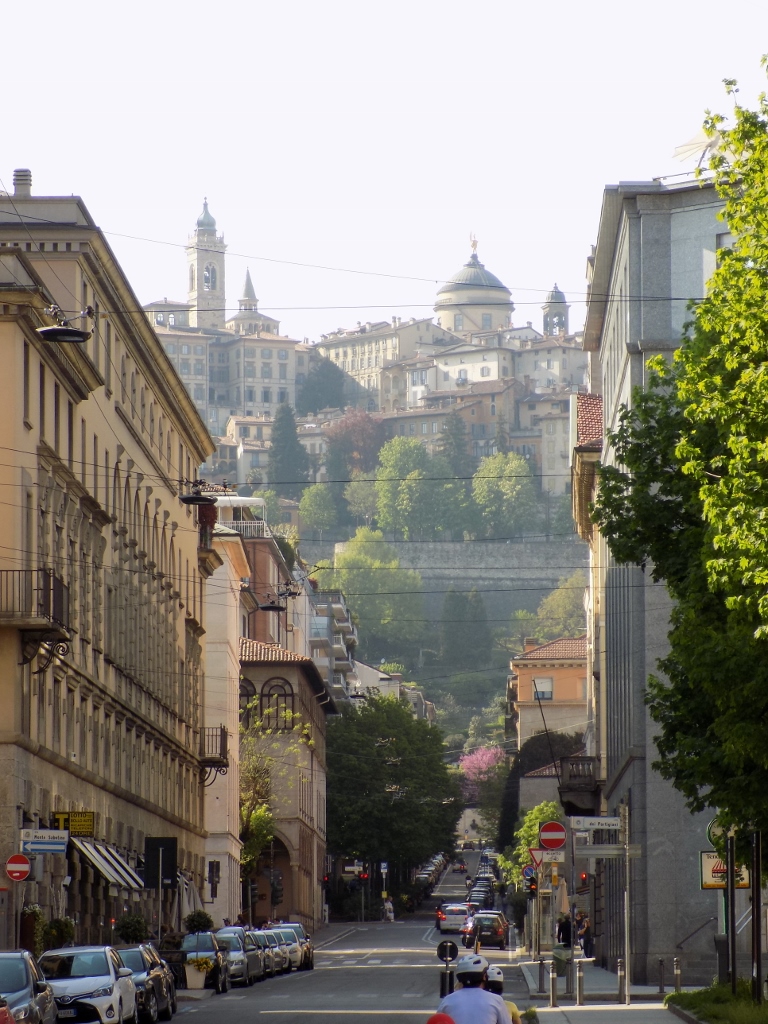 View at the Upper Town in Bergamo
View at the Upper Town in Bergamo
Having in mind how much I walked that day, especially up and down, I was no longer too keen on moving, but it was still daytime. I did plan to come to one of these bars later on, but before that I decided after all to take yet another walk around the neighbourhood, just along the flat terrain. I felt the need and I had a desire to have another good rest that night because, finally, this was my vacation and not an exhaustion competition.
Walking around the area, I suddenly heard a sound that seemed like a river. I was puzzled and followed the sound. As it turned out, there is indeed a small river and even apparently a small electric power plant on it, but the most interesting element was that the water came by a canal that went under the streets and buildings, and after a few hundred metres the river disappeared in the same way under the town. This did seem a little odd to me and I hardly managed later on to find out that this was in fact a local river Morla.
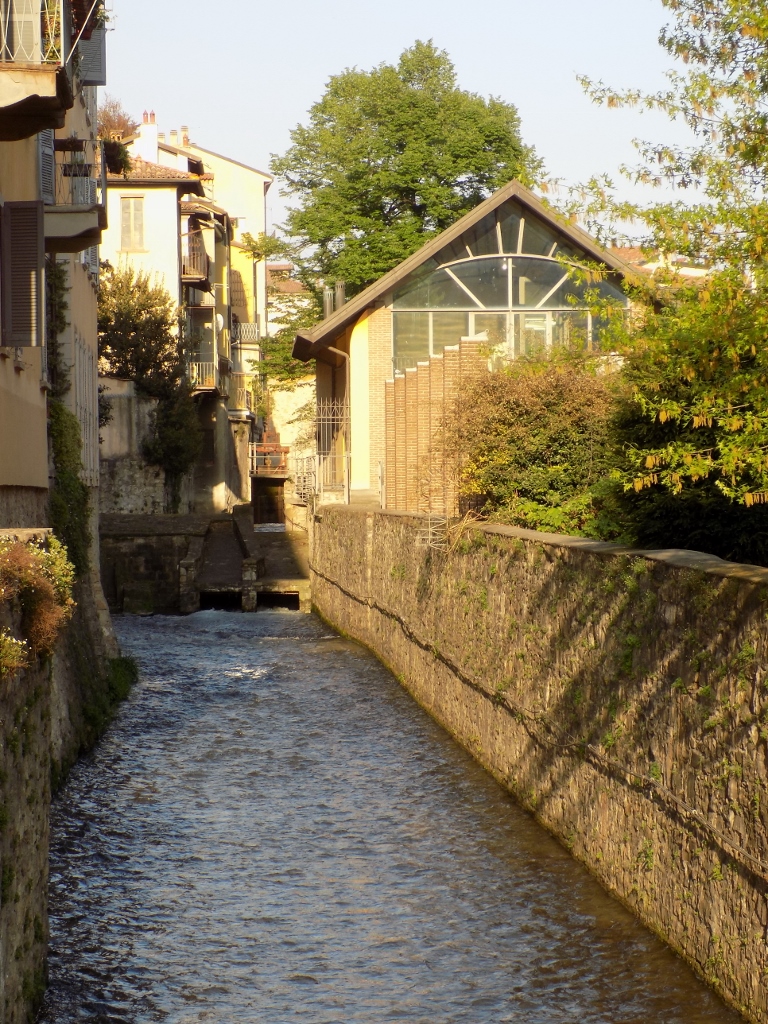 The Morla river
The Morla river
The following day, I was very much laid back, on top of which I wasted quite a lot of time trying to include a visit to a small and interesting place between Bergamo and Milan into my day, but this turned out to be too complicated, especially if this was to be combined with a visit to Milan. So, I gave up this escapade and went “only” to Milan.
I had already been in Milan on a couple of occasions, but both times quite a long time ago. Also, each time I somehow missed out on visiting a Dominican convent Santa Maria delle Grazie, in the refectory of which there is the Leonardo’s Last Supper. When I planned this trip to Italy, I thought I would buy on the internet an entrance ticket to see the fresco. Tough luck! A month before my visit, all the tickets had already been sold out for a few months in advance! I did think I could perhaps just show up there and try my luck on the spot, but as it turned out I was in Milan on a Monday when the refectory was closed anyway.
Since I had ambitious plans for my day’s visit to Milan anyway, right after getting there I bought a day’s ticket for the public transportation, counting actually only on using the underground. I thought there was no need to walk around Milan more than necessary.
I got out of the underground close to the Teatro alla Scala, but the first things I came across were actually lots of noise and traffic. After the quiet Bergamo on a weekend this was a real, but not pleasant, sound attack. Milan is a beautiful city, there are a lot of very interesting things and places to see, but at this moment I thought I could never live there.
So, the famous La Scala is the venue that is probably the ultimate opera temple. Still, I’ve always found it interesting how the building itself is right there directly in the street. The building is nice, but I still find it odd that right next to its gates there are cars and public transportation.
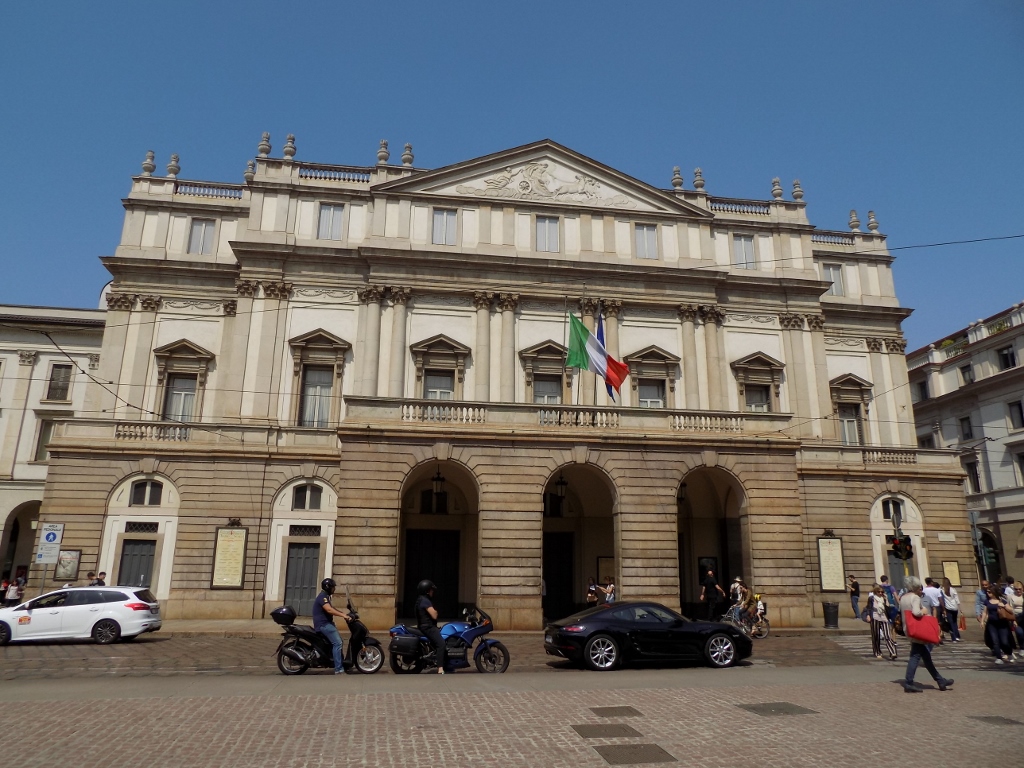 La Scala
La Scala
Still, there is a broader space right across the street where there is a small park with a large monument to Leonardo da Vinci, who was a “guest” here at the invitation of the Duke of Milan, Ludovico Sforza. Leonardo was actually born in Tuscany, in the small village of Vinci not far from Florence, but he spent a part of his life in Milan (1482-1499). This square leads into the imposing Galleria Vittorio Emanuele II, the oldest active shopping mall in Italy.
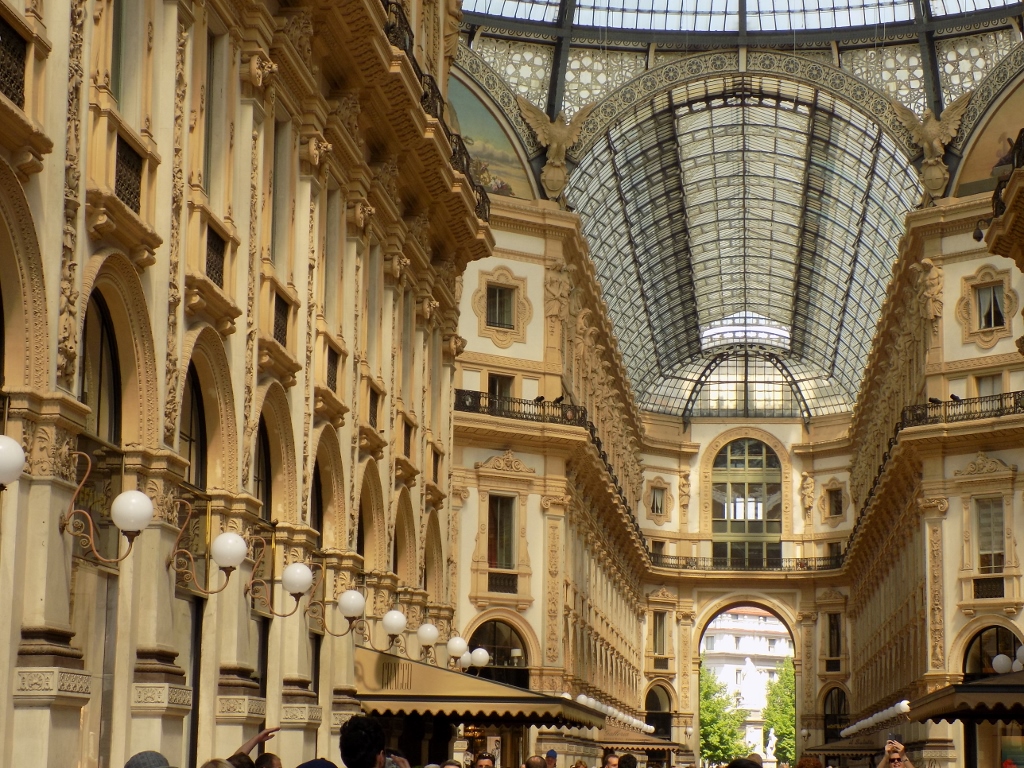 Galleria Vittorio Emanuele II, in the distance, through the arch, it is possible to see the monument to Leonardo da Vinci
Galleria Vittorio Emanuele II, in the distance, through the arch, it is possible to see the monument to Leonardo da Vinci
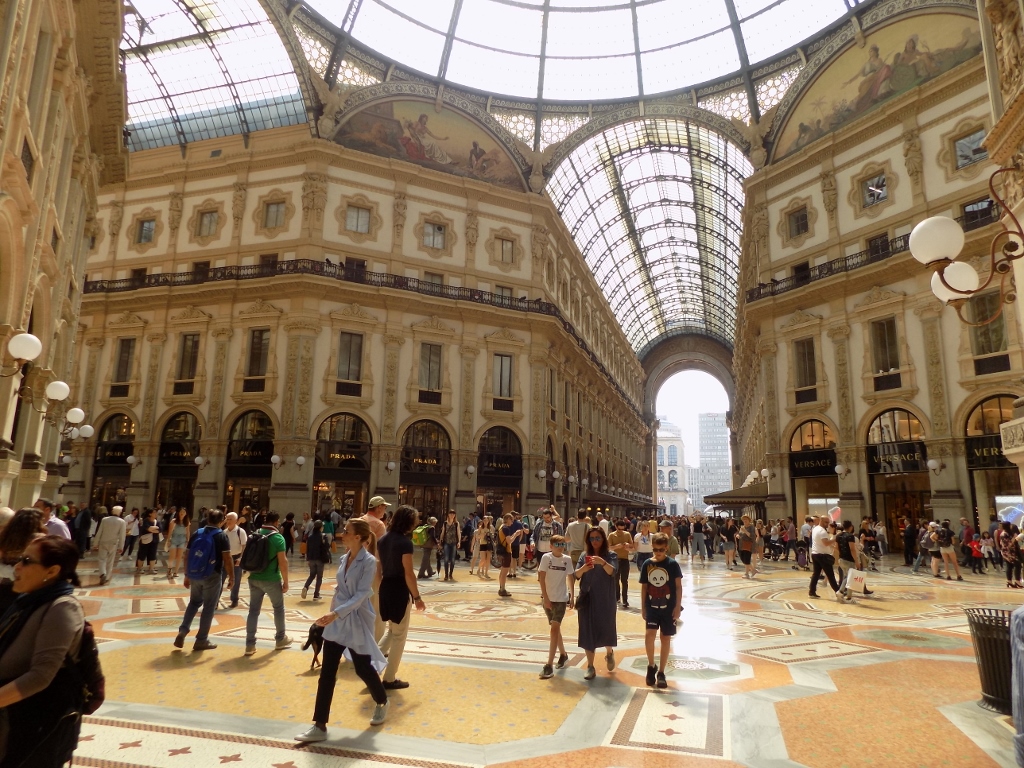 Galleria Vittorio Emanuele II
Galleria Vittorio Emanuele II
In turn, the Galleria Vittorio Emanuele II leads to the Piazza del Duomo, that is, to the square with the Cathedral. I have to admit that I could not recall (and I had been too lazy before the trip to dig through my photos) if I had ever entered the Cathedral before (and I must have), so I decided to do it this time, just in case. I also decided to be a proper tourist and climb onto the roof. In order to do this, there are two ways. In both cases, one has to pay, but there is a slower and an apparently faster way, that is, a cheaper and a more expensive way. I chose to give myself a treat, to take the faster way and to climb to the roof by an elevator. However, while I was waiting in the line for the tickets, which moved unbelievably slowly, I saw some people before me giving up, since they were told at the counter that they had to wait for half an hour to get into the elevator. I also gave up and that meant that I paid less for the ticket, but I had to wait to get into the Cathedral for more than half an hour. Namely, there is a very careful control of all who want to enter the Cathedral.
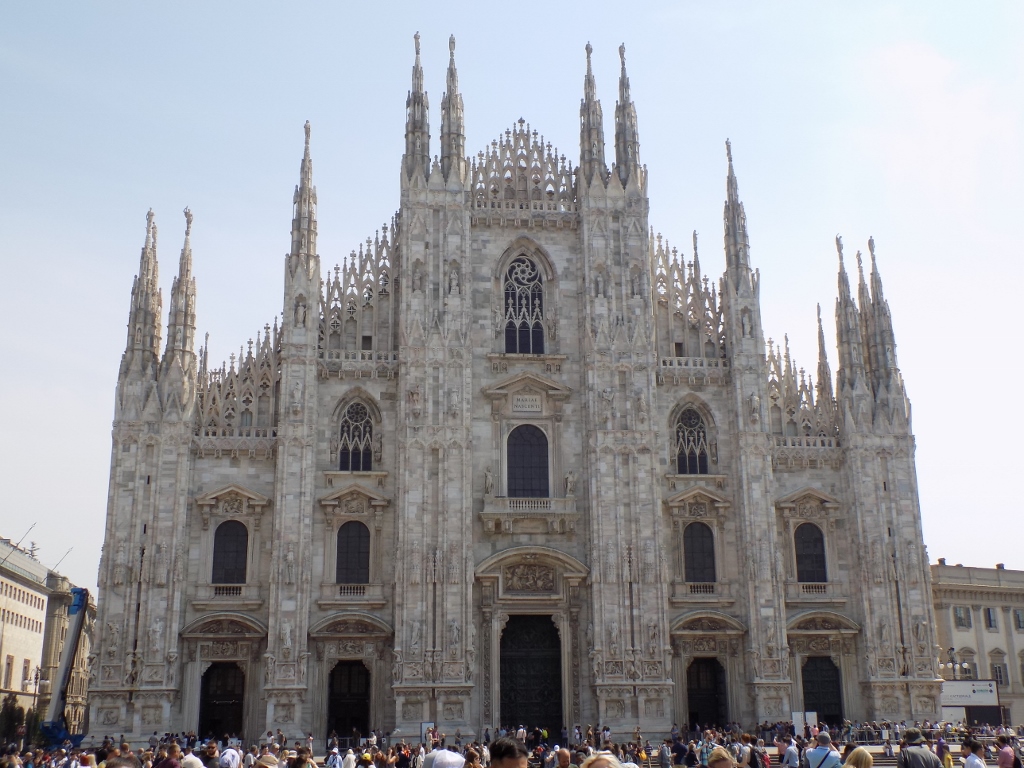 The Cathedral in Milan, the front facade
The Cathedral in Milan, the front facade
And so I stood in the burning sun for a while and when I finally got in I couldn’t say it even to myself whether it was worth all that waiting.
The building of this immense cathedral that is covered in marble started at the end of the 14th century and it continued until the beginning of the 19th century when the facade was completed. In interior decorations are comparatively modest, but more than fifty incredibly high columns do make a strong impression.
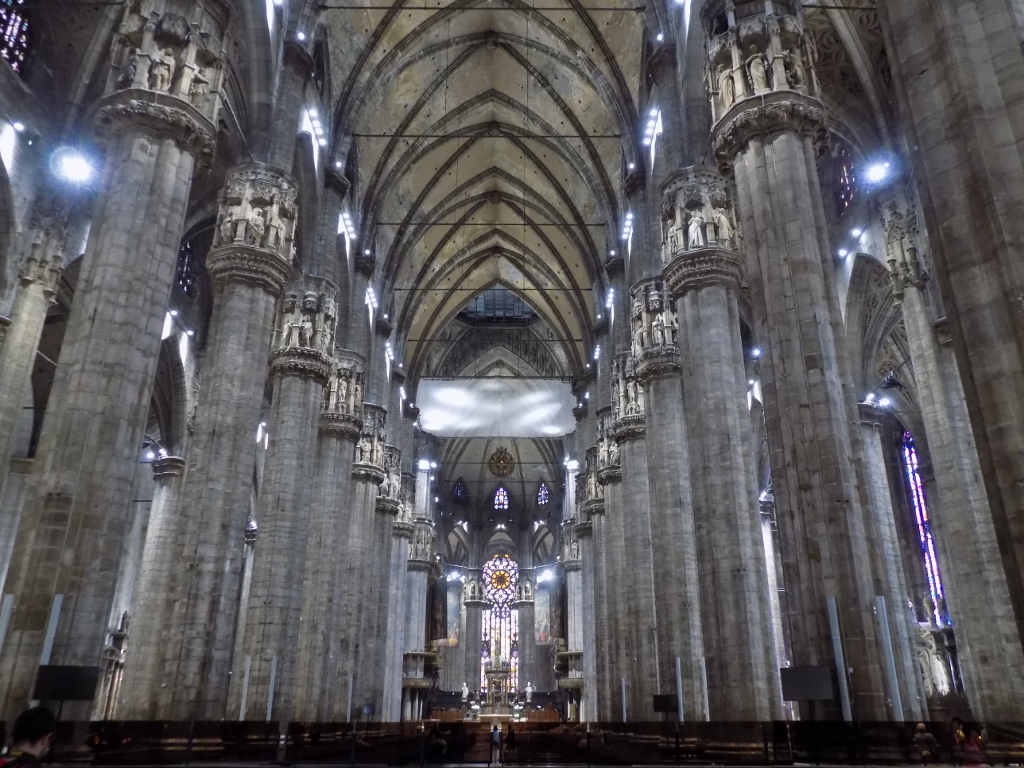 Milan’s Duomo, the interior
Milan’s Duomo, the interior
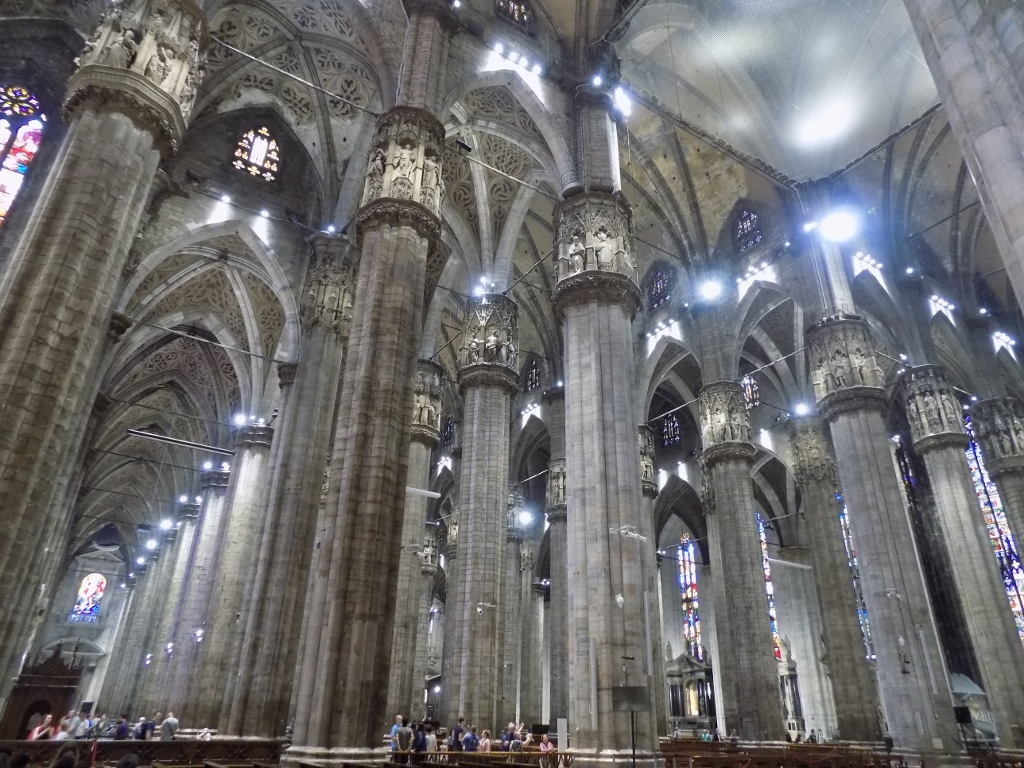 Milan’s Duomo, the interior
Milan’s Duomo, the interior
Since I did try to get in, I walked a little around the cathedral and then I went out and to the entrance where there are steps leading to the roof. So, I did have to go up on foot in the end. There are, as they say, 261 steps and although I had to stop a couple of times in order to catch my breath, I was actually shocked by how fast I managed to get to the top.
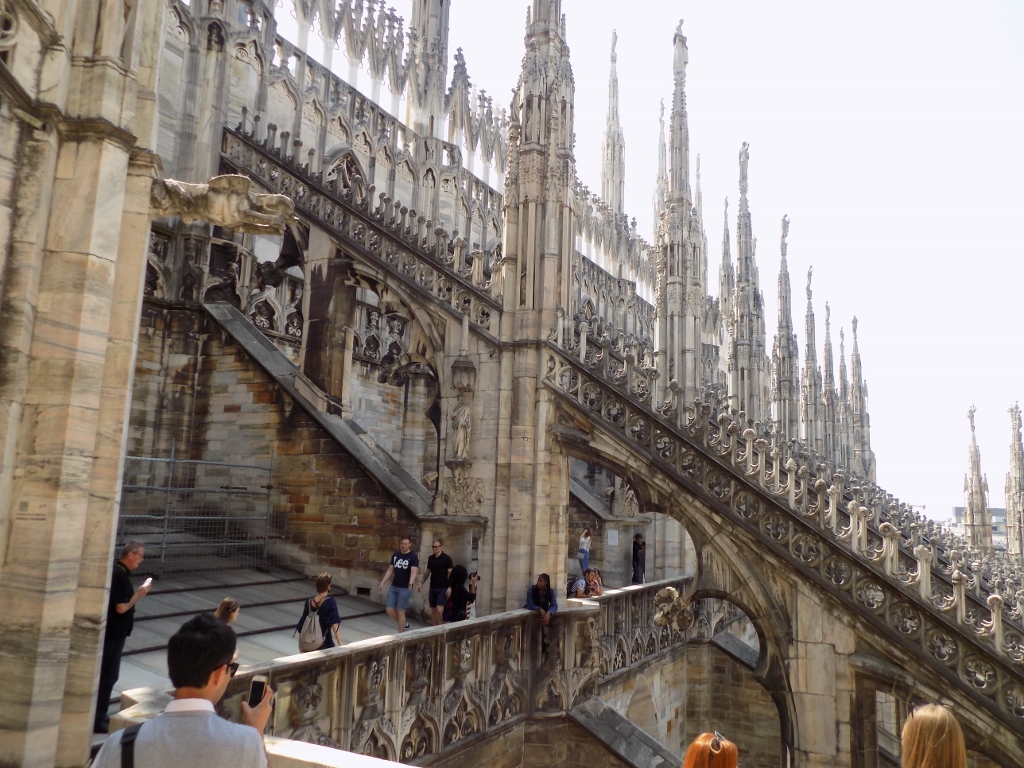 Milan’s Duomo, on the roof
Milan’s Duomo, on the roof
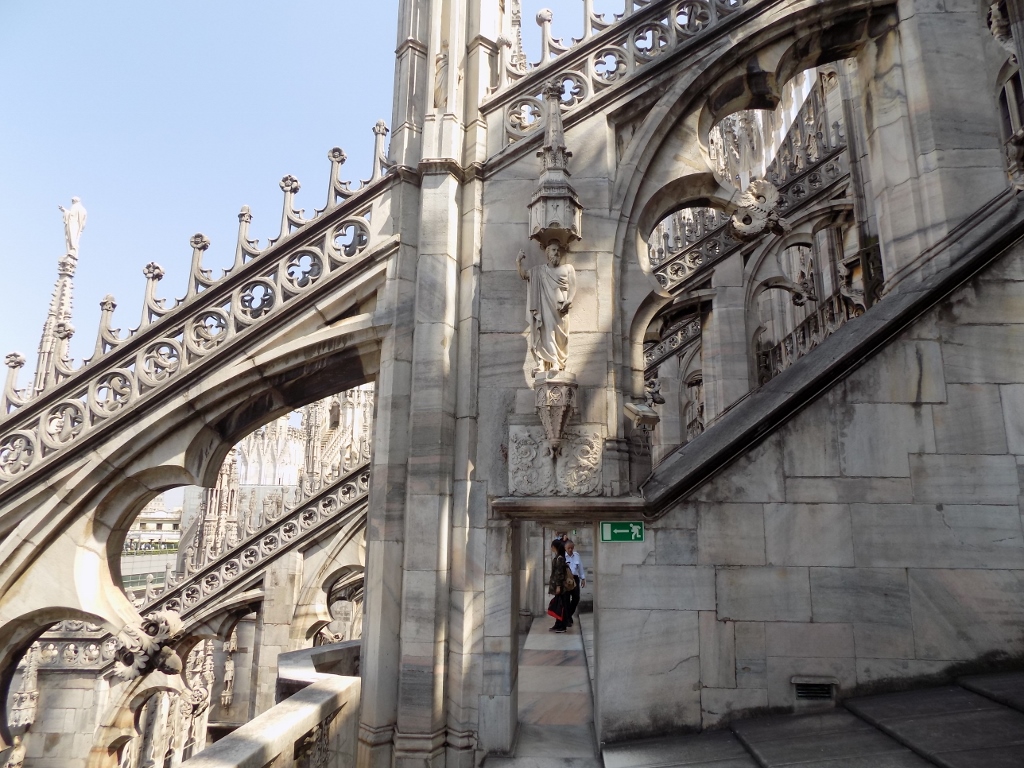 Milan’s Duomo, on the roof
Milan’s Duomo, on the roof
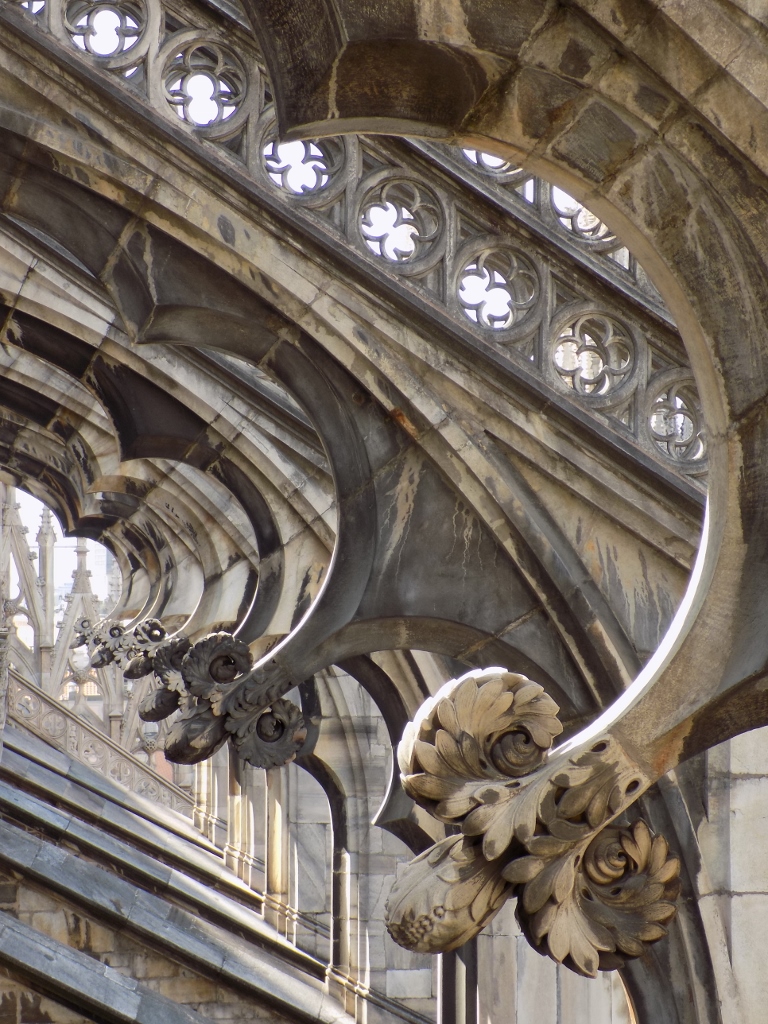 Milan’s Duomo, a detail from the roof
Milan’s Duomo, a detail from the roof
Here, too, I wondered if it was all worth the trouble and effort. And still I reached no meaningful conclusion, but I did walk around, took a few photos, went down and then moved on.
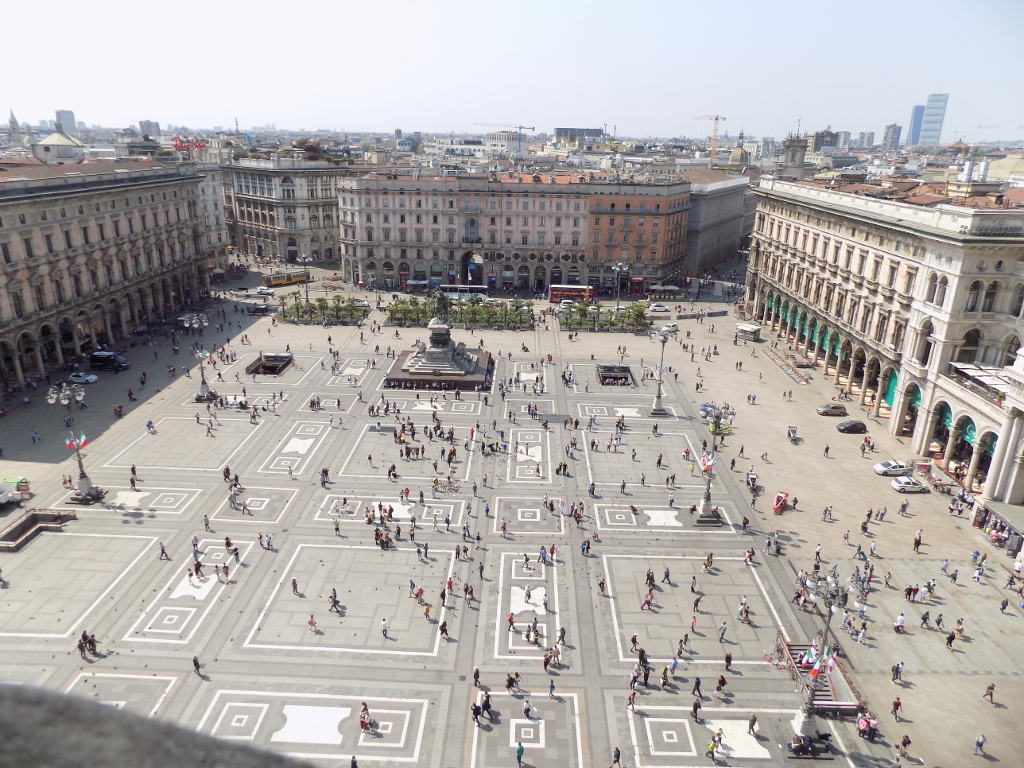 View at the square in front of the Duomo
View at the square in front of the Duomo